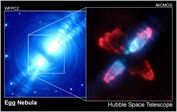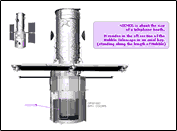 |

 Seeing in Infrared
Seeing in Infrared
The Egg Nebula is shown in visible light on the left.
On the right, NICMOS is able to see through obscuring
dust to the heart of the nebula. |

 Hubble and NICMOS
Hubble and NICMOS
NICMOS is about the size of a telephone booth. It is located
in the aft section of Hubble in its axial bay. |
|
 |
 |
Summary
The
Near Infrared Camera/Multi-Object Spectrometer or
NICMOS, gave astronomers their first clear view
of the universe at near-infrared wavelengths (between
0.8 and 2.5 micrometers) - out of the range of the
human eye and previous Hubble instruments.
Various secrets about the birth of stars, solar
systems, and galaxies are revealed in infrared light,
which can penetrate the interstellar gas and dust
that block visible light. In addition, the light
from distant receding objects (the universe is expanding)
shifts into infrared wavelengths (called red-shift).
By studying objects and phenomena in this spectral
region, astronomers probe our universe's past, present,
and future, study how galaxies, stars, and planetary
systems form, and learn a great deal about our universe's
basic nature.
NICMOS has three channels giving it the
capability for both infrared imaging and spectroscopic
observations of astronomical targets.
| NEXT

|
|
 |
 More
. . . More
. . . |
 |
 |
 |
3D
animation of Hubble - zooming in close to
the location of NICMOS. |
|
 |
 |
 |
 |
Interactive
3D model of Hubble which you can rotate at
different angles. |
|
 |
 |
 |
|
|
 |
